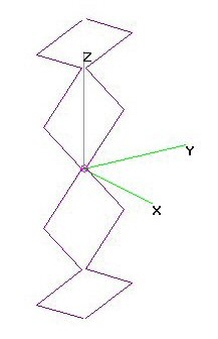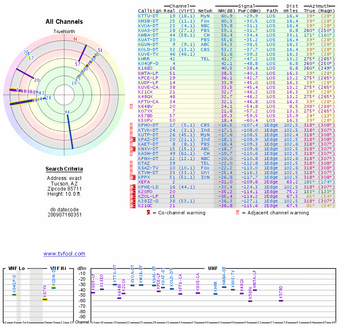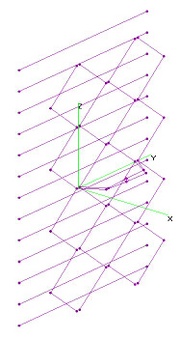 | 1.
UHF 4-Square Free Form Chireix (15 Oct 2014)4-Square Chireix, Free Form (Unequal Inner/Outer Lengths & Angles) Antenna with
NO Reflector and also 11 Reflector Rods analyzed using 4nec2.
There are FIVE Gaps: Center Feedpoint, Outer Apexes and In-Between. See respective
Front Views & 4nec2 Files. Dimensions from nikiml's Python Optimization Scripts.
Both versions had 4-5 dB Loss on lowest channels and No Reflector had 2.6 dB Loss on
highest Channels, so Stagger-Tuning alone was insufficient for Full UHF Band coverage.
Four-Unequal-Diamonds with 11 Reflector Rods had MUCH better performance:
http://imageevent.com/holl_ands/multidiamond/uhf4unequaldiamonds11reflrods
a) UHF 4-Square Free Form Chireix - NO Reflector:
UHF Raw Gain = 5.7 to 10.0 to 7.4 dBi and SWR (300-ohms) under 1.9.
b) UHF 4-Square Free Form Chireix + 11RR:
UHF Raw Gain = 8.5 to 14.3 to 14.2 dBi,
F/B & F/R Ratio Minimum = 15.1 dB and SWR (300-ohms) under 12.5. |
| 17601 Visits
27 Images
Gallery Album | |
|
 |
|
 | 3.
UHF Chireix Antennas (NO Reflector) (17 Aug2009)UHF Chireix Zig-Zag Antennas (NO Reflectors) analyzed using 4nec2.
Henri Chireix's Canadian Patent CA285256A is dated 12 Apr 1928:
http://brevets-patents.ic.gc.ca/opic-cipo/cpd/eng/patent/285256/summary.html
http://lost-contact.mit.edu/afs/club.cc.cmu.edu/usr/sdavis/pdfs/chireix-mesny.pdf
2-Square Whisker Length = WL = 10.0-in (at 45-deg) assumed in this Analysis.
To reduce excessive SWR in 2-Square WL=10.5-in is advised.
4-Square WL=10.25-in [SWR under 2.6] and for 6-Square and
8-Square WL=10.5-in is assumed [SWR under 2.6]. All AWG12.
As more "squares" are added to the Chireix, the Gain is increased with
increasingly reduced Bandwidth.
Although a square box (45-deg to horizontal plane) is typically used, a
slightly higher Gain was found in a 4-Square Chireix at 40-deg.
A Free-Form 4-Diamond Chireix can be found here, with "BEST" Angles and Lengths:
https://imageevent.com/holl_ands/chireix/uhf4squarechireixfreeform
EDIT (2Mar2018): Added 4nec2 Files and Dimension Info. |
| 21275 Visits
27 Images
Shared Album | |
|
 | 4.
Chireix Zig-Zags (With Reflectors) (30Aug2009)UHF Chireix Zig-Zag Antennas (with Reflectors) analyzed using 4nec2.
In RevA, Zig-Zag Wire Lengths in top-left quadrant were slightly different than other quadrants.
NO significant performance differences were found after making them all the SAME (RevB, also RevX),
see Chart at bottom.
RevC (C-Cups), RevX (Top-Hats) and RevR (Roof) added NARODS to improve Hi-VHF performance, although at expense of UHF.
RevA, B, C, X and R employ STAGGER TUNING, wherein the Wire Lengths for "Zigs" connected to the center SOURCE wire
are longer than the "Zags" returning back towards the Z-axis.
RevD and RevH are standard 2-Square Chireix Antennas wherein all Wire Lengths are the SAME, at 45-degree angles.
RevD provided more Gain at higher frequencies, using the same 12 Reflector Rods as Rev A/B.
RevH (Big Screen Reflector) provided much higher F/R and F/B Ratios and good Gain across the New UHF Band.
Screen size is same as RevA/B Reflector Rod footprint....and may be larger than needed.
2-Square Chireix and X340 variants have LESS Gain than the CM4221 4-Bay, and NONE are suited for use on Ch52-69 (like the CM4221).
4-Square Chireix has more Gain than CM4221 mid-band, but drops off at very low and very high frequencies with lower F/R and F/B Ratios.
Hi-VHF Performance to be provided in the near future....
EDIT (28Apr2011): Corrected Dimensions in 4-Square Chireix - Front View. Corrected comment: [One small box = 1 inch] 60'H x 32"W Reflector
Results and 4nec2 file are unaffected. Added Raw Gain, SWR, Impedance and Azimuthal Pattern Charts for 4-Square Chireix with Reflector Screen. |
| 12826 Visits
37 Images
Shared Album | |
|
 | 5.
Chireix 2Square w Slanted Reflectors (10 Sept 2009)UHF Chireix Zig-Zag Antennas with SLANTED Reflectors analyzed using 4nec2.
In response to Vorg's situation with THREE widely separated tower groups.
See the SBGH Gray-Hoverman alternatives. They seem to be better suited for his situation..... |
| 10135 Visits
18 Images
Shared Album | |
|
 | 6.
Chireix-Mesny Zig-Zags (NO Reflectors) (1Sep2009)UHF Chireix-Mesny Zig-Zag Antenna Arrays (NO Reflectors) analyzed using 4nec2.
Henri Chireix's Canadian Patent CA285256A is dated 12 Apr 1928:
http://lost-contact.mit.edu/afs/club.cc.cmu.edu/usr/sdavis/pdfs/chireix-mesny.pdf
SRC presumes the two side-by-side Chireix Antennas are driven by two separate (synchronized) transmitters
to investigate how well it would perform without complications due to an interconnecting Feedline.
Because 4nec2 is normalizing Gain, the power increase due to two separate transmitters is not evident in the plots.
BTW: This arrangement was reportedly used in the early days of Radio.
TL1 investigates Transmission Feedline Type 1, which results in a best fit to a 75-ohm load.
TL3 investigates Transmission Feedline Type 3, which results in a best fit to a 150-ohm load and not quite as good to 300-ohm load.
All feedline wire segments in TL3 are 5.1-in long, maintaining 0.75-in spacing (easier to do in metal than in 4nec2!!!).
EDIT (3Sep2009): Analyzed 2x4Sq Feedline BEHIND Zig-Zags (TL3B) where it contributes to Max Gain in the FORWARD direction. |
| 15918 Visits
31 Images
Shared Album | |
|
 | 7.
Chireix-Mesny Arrays (With Reflectors) (1 Sep 2009)UHF Chireix-Mesny Zig-Zag Arrays (with Reflectors) analyzed using 4nec2.
Excellent Gain: 15-16.8 dBi over most of the New UHF Band and 12 dBi at Highest & Lowest Freqs.
Excellent SWR: Under 2.6 with 300-ohm load.
F/B and F/R are moderate (13-18 dB) and could be improved with an optimized Reflector system. |
| 44442 Visits
8 Images
Shared Album | |
| |
| 8.
Hi-VHF+UHF Stealth Hawk (25 Apr 2010)"Stealth Hawk" modifications to the 2-Square Chireix antenna were analyzed using 4nec2, based on some postings by ota_canuck:
http://www.digitalhome.ca/forum/showthread.php?t=123803
Two variants are analyzed: lower element Swept Back (bottom elements on Chireix splayed outward) and also Swept Forward (X29). |
| 4 Albums
Shared Folder | |
|
 | 9.
UHF + Hi-VHF V-Hawk by Ronbo (4 Aug 2015)Hi-VHF + UHF V-Hawk Antenna analyzed using 4nec2. Dimensions as per 4nec2
Files posted by user [Ronbo]. His Assembly Instructions & Photos are at bottom of this Webpage.
Note that V-Hawk wires are CONNECTED at the Top and Bottom, whereas
Stealth-Hawk has a GAP, hence it is NOT formally derived from the Chireix.
Three versions were analyzed, with 30, 45 and 60-deg Forward Swept Angles:
====================================
a) UHF + Hi-VHF V-Hawk - 30-deg Angle:
UHF Raw Gain = 10.8 to 14.3 to 10.7 dBi and SWR (300-ohms) under 1.8,
with Primary Lobe Forward and Secondary Lobes 110 to 120-deg away.
Hi-VHF Raw Gain = 5.2 to 6.2 dBi, F/B & F/R = 0.3 to 0.4 dB and
SWR (300-ohms) under 2.3 with Bi-Directional, Quasi-Omni Coverage.
====================================
b) UHF + Hi-VHF V-Hawk - 45-deg Angle:
UHF Raw Gain = 9.6 to 14.3 to 12.2 dBi and SWR (300-ohms) Under 1.8,
with Primary Lobe Forward and Secondary Lobes about 90-deg away.
Hi-VHF Raw Gain = 4.6 to 5.3 dBi and F/B & F/R = 0.5 to 0.7 dB and
SWR (300-ohms) under 2.3 with Bi-Directional, Quasi-Omni Coverage.
====================================
c) UHF + Hi-VHF V-Hawk - 60-deg Angle:
UHF Raw Gain = 7.6 to 12.3 to 10.3 dBi and SWR (300-ohms) under 2.3,
with Very Wide Beamwidth Forward and minimal Gain to Rear.
Hi-VHF Raw Gain = 4.0 to 4.2 dBi, F/B & F/R Ratio = 0.3 to 0.7 dB and
SWR (300-ohms) under 4.4 is Excessive with Quasi-Omni Coverage Pattern. |
| 7659 Visits
64 Images
Shared Album | |
| |